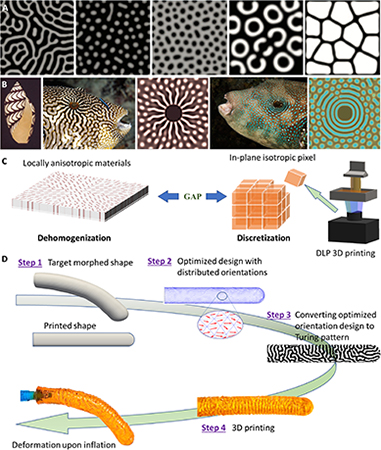February 21, 2023
By Ashley Ritchie
Turing patterns are self-organizing patterns with stripes or spots and are widely found in biological systems and nature at multiple spatial scales, such as lizard skin, fish skins, and sand dunes. Although Turing patterns are abundant, they have not been widely studied in engineering or, in particular, in material design and additive manufacturing. Instead, inflatable shape morphing structures have attracted significant research attention.
Traditional inflatable structures use isotropic materials with geometrical features to achieve shape morphing. Recently, gradient-based optimization methods have been used to design these structures. These methods assume anisotropic materials whose orientation can vary freely, which makes fabrication of these structures a major challenge.
A new study from a team of researchers at the Georgia Institute of Technology, Toyota Research Institute of North America, and Toyota Central R&D Laboratories uses Turing patterns to bridge the gap between material orientation–based optimization design and 3D printing.
In a recent paper published online in Science Advances, the group implemented a technique to design and fabricate inflatable actuators using topology optimization with the Turing pattern.
“Specifically, we use Turing patterns to convert a design with distributed anisotropic materials to a distribution with two materials, which can be fabricated by grayscale digital light processing 3D printing,” said Jerry Qi, co-author and professor in the George W. Woodruff School of Mechanical Engineering.
Anisotropic design through topology optimization is a powerful method to produce unique mechanical parts, but creating a physical structure with these small anisotropic domains is difficult due to the continual spatially varying fiber orientation.
“Our method addresses this limitation by inserting the globally optimized anisotropic tensor into the Turing reaction-diffusion equations as the anisotropic diffusion tensor. This causes the two competing species to evolve anisotropically in a way determined by the optimized orientation tensor,” said S. Macrae Montgomery, co-author and mechanical engineering Ph.D. student.
The outcome is a bi-phase pattern of soft fiber and stiff matrix material that mimics the result from topology optimization. Importantly, the mechanical response of the achieved bi-phase pattern matches the target design. The Turing pattern design can then be readily fabricated using the advanced grayscale digital light processing (g-DLP) 3D printing technique, which uses a variable light intensity to locally control the stiffness throughout a part created from a single liquid resin vat.
The research represents a practical method for using the Turing pattern for material design in structure and functional applications. The study’s findings also suggest that it’s possible to apply patterns in biological systems and nature to engineering composites and offers new concepts for future material design.
“The results also lead to many interesting scientific questions for future studies,” added Montgomery. “For example, can we decipher the Turing patterns seen in biological systems and investigate if they have any connections to the functions of these systems? It is intriguing to ask if we can decipher the Turing pattern to obtain the original material distribution through analyzation without conducting FEM simulations.”
In addition to Qi and Montgomery, the study’s authors include Yaochi Wei, a former postdoctoral fellow in Qi’s Active Materials and Additive Manufacturing Lab; Liang Yue, a current postdoctoral fellow in Qi’s lab; and Tsuyoshi Nomura, Masato Tanaka, and Yuyang Song of Toyota Research Institute of North America.
About the Research
Funding: This project was partially supported by Toyota Motor North America Inc. H.J.Q. also acknowledges an AFOSR grant (FA9550-20-1-0306; B.-L. “Les” Lee, Program Manager), a fund from HP Inc.
Author contributions: M.T.: Writing—original draft, conceptualization, software, and methodology. S.M.M.: Writing–original draft, formal analysis, investigation, and software. L.Y.: Writing—review and editing and methodology. Y.W.: Methodology and investigation. Y.S.: Conceptualization and supervision. T.N.: Software, methodology, and supervision. H.J.Q.: Writing—original draft, resources, funding Acquisition, and conceptualization.

